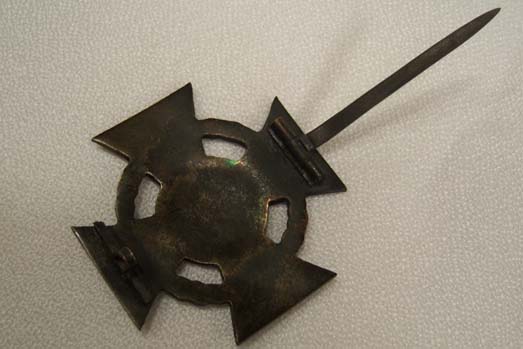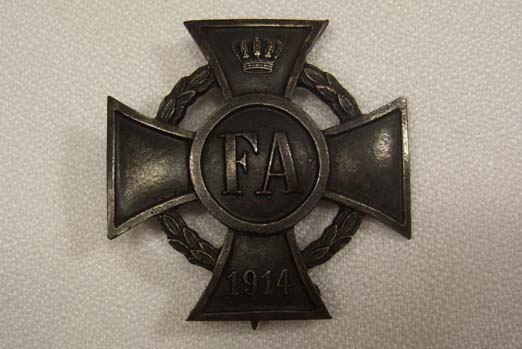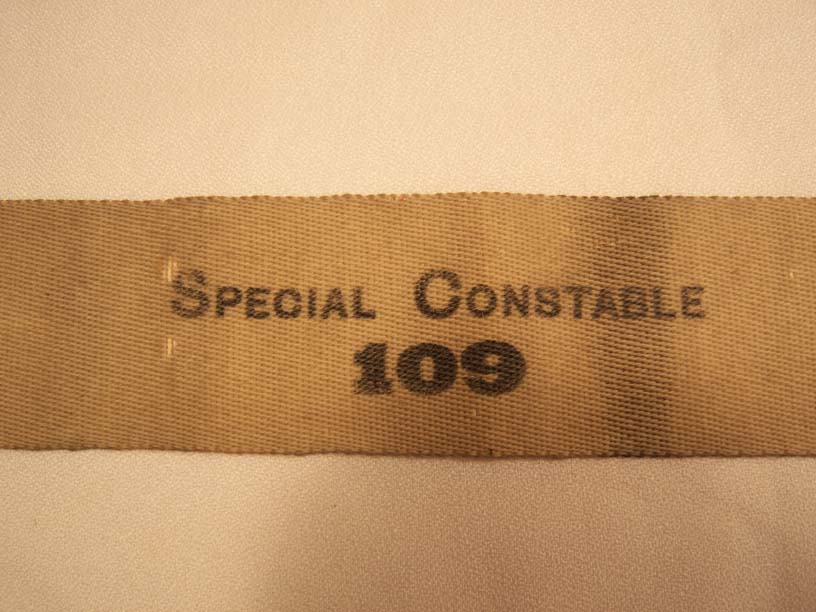-
Posts
6,486 -
Joined
-
Last visited
-
Days Won
10
Content Type
Profiles
Forums
Blogs
Gallery
Events
Store
Posts posted by Brian Wolfe
-
-
Hi Tom,
As usual the one in my collection is not fitting in either category.
Mine is NOT made of iron but has the concave centre, though you would not know so much so from the photo.
It is not as well defined as your example but it is definitly not smooth on the reverse.
Regards
Brian
0 -
The WW2 Defence Medals were never as far as I am aware officially issued named.
Kevin in Deva.

Just to clairify, India and South Africa both named their medals including the WWII Defence Medals.
Regards
Brian
0 -
Wow! Thanks Heiko.
That sure shows the cross in wear as well as where is was worn in relationship to the EK.
Many thanks
Brian
0 -
A very utiltarian look to it - a WWI item?
Hello Leigh,
Yes, I believe it to be WWII era. Thanks for drawing that oversight to my attention.
Regards
Brian
0 -
Here is the reverse. There are no maker's marks what-so-ever on this specimen.
Regards
Brian
 0
0 -
Hello Everyone,
I wanted to post one of my newest additions to the collection, an Oldenburg Friedrich August Cross 1st Class.
I seems to be a nice clean example, a bit different from some that I've seen which look to have been iron and painted black. This one seems to be blackened bronze (a non-ferous metal). I don't know much about the history of these medals as far as the material they were made from. If they were made from different metals, that is to say iron and then brass, would this make this example a later minting?
Ulsterman, would you be so kind as to post your photo of the officer wearing the Oldenburg Cross 1st class here? It would be most appreciated, and would really round out the post.
Regards
Brian
 0
0 -
Lastly a close view of the buckle and the teeth which grip the cloth armband.
Regards
Brian
 0
0 -
Here's a closer look at the "Special Constable 109" stamp.
 0
0 -
Hello fellow Special Constabulary collectors,
I thought I'd better give this section some resuscitation before it suffers a fatal case of atrophy. This arm band just arrived today. It is made of canvas (cotton) and measures 42cm (16 1/2 inches) in lenght and 5 1/2cm (2 1/4 inches) in width. The buckle is made of brass and grips the cloth band by means of 4 very sharp teeth.
The seller said it comes from London but that could be just the origin of the band and not the Police Service in which it was employed.
The colour of the band is accurately represented in the first photo. The second and third photos are not the correct shade, something to do with my photography I am sure.
I hope you like my newest addition.
Regards
Brian
 0
0 -
Excellent work.
The next project, what will that be?
Regards
Brian
0 -
Exceptional collection Mervyn.
Thanks for displaying them here.
Regards
Brian
0 -
Many thanks Ulsterman.
I really like photos of medals in wear but to be honest I never thought I'd see the 1st Class Oldenburg Cross in wear. I know that sounds like I think I've seen it all but that's not the case. I would imagine these are quite rare especially if compaired to the Prussian Iron Cross.
Thanks again Ulsterman, you are a true gentleman and a scholar, and from what I have seen on another post a Fly Fisherman!

Regards
Brian
0 -
I have had a really nice 1915 erfurt G98 that has a lot of character and charm but has one problem - missing upper handguard!
Anyone know someone who has one or anybody who makes them?
Hello zarusthra,
I would think that you could have one made if you can't find an original. Considering where you live it should not be difficult to find someone. As a woodworker myself I have noticed that there seems to be a lot of very skilled craftsmen (and women) in your neck of the woods. Good luck and please keep us posted especially if you have one made. I think we need to be more aware and knowledgable of, what I will call, restoration work and the making of replacement parts. Very interesting stuff.
Regards
Brian
0 -
Hello Iver,
I am in awe of this post. I was thinking that having the medal and then the portrait was amazing but then to have the photo of his final resting place. Very nice indeed.
I agree with Magician that it would be great to find out what he did to earn the decoration. Of course I am sure you feel the same way. If you do find out please be sure to post it as I am know many would be interested as well.
Regards
Brian
0 -
Those were designed and made by Honeywell at the TCAAP, Twin Cities Army Ammunition Plant in New Brighton Minnesota, USA. The shrapnel balls were made from wire roughly formed
in a press then tumbled round, at one time Honeywell had the largest die cast department in the USA making these bomblets. Several more were developed, some smaller in diameter and a rather larger one made from a stamping with plastic bonded on the outside. The vanes cause the bomblet to spin flight arming a fuze, the fuze hammer would make contact with a bit of
contact cement and remain held until the bomb hit causing detonation, some bombs would actually delay for up to several hours.
Several more AREA DENIAL weapons were developed by Honeywell most with a scatterable attribute by plane, Helicopter, and Artillery. Some of these were reworked into special hand
thrown mines for the Navy Seals. The cluster bomb used in Iraq was the CBU, Cluster Bomb Unit that dropped an anti- armor/ anti- personal bomb, I recall there were 96 bombs in a
CBU and each bomb-let penetrated nine inches of armor. This was the weapon that that caused the road of death in the first Iraq war.
The other interesting bomb was the Fax, or Fuel Air Explosive that caused massive overpressure when detonated.
Regards
Dresden
Hello Dresden,
First, allow me to echo Mervyn in welcoming you to the forum.
I have seen the photos of the devistation on what you refered to as the "road of death in the first Iraq War" and never knew that these were the little buggers that were responsible. Like so many such weapons they don't look all that harmful until they are deployed. Thanks for the historical background, it was quite interesting.
Regards
Brian
0 -
Hi Brian:
"Is that an Oldenburg Cross 1st Class the fellow is wearing?"
I think, it is the first class of the Prussian War Veterans Organisation.
Uwe
It was hard to see in the photo and I was going by the general shape. Upon closer view I can see that there seems to be more printed on the cross than just the "FA" in the centre of the Oldenburg.
Thanks
Brian
0 -
Yup...... that`s the first class.... nice looking award in white / gold
So...it is the 1st class Prussian War Veteran's Organization Cross and not the Oldenburg cross?
I don't want to be confused about this.
Regards
Brian
0 -
Indeed!
Hi Ulsterman,
Is that an Oldenburg Cross 1st Class the fellow is wearing?
I the mail Gods are kind I have one coming for my collection this coming week (I hope).
Nice photo by the way.
Regards
Brian
0 -
Welcom Sid,
I have one of these somewhere in a drawer and I was told they are called fleshettes (spelling is probably wrong). They were anti-personnel and dropped from planes. I don't know if they were delivered inside an explosive device or just dropped, from the shape and the tail fins I would think they were just dropped. I look forward to hearing from more knowledgable members on this interesting little artifact.
Regards
Brian
0 -
Thanks Ulsterman, it's not spectacular but I really liked it when I saw it for sale.
Regards
Brian
0 -
Very nice indeed Dieter, congratulations.
Regards
Brian
0 -
Sorry Brian, we were talking in "german".... MVK = Militär-Verdienst-Kreuz = Military merit cross
The one on your bar is the lowest class of this cross for regular soldiers or lower class NCO`s : MVK 3.class with swords , the typical bavarian standart award during ww1 for soldiers.
For upper class NCO`s the cross had a additional crown over the swords and then came the two higher classes with enameled centre - very nice award.
The officer version is the blue enameled MVO = Militär-Verdienst-Orden = military merit order , that came in several classes too...
You will find nearly all classes of the cross and the order when you search the forum for older threads...
cheers

Heiko
Hello Heiko,
Thank you for the information and I will indeed be searching through the old threads. Where else can one find so much information about so many topics all in one place other than at GMIC.
Regards
Brian
0 -
There is never enough words to express the beauty of these blades.
Very nice indeed.
Regards
Brian
0 -
Please accept this in the spirit presented - help not being a twit.
Verdienst = Merit not service - that is a Military Merit Cross not War Service Cross.
Assistance is always welcomed and never taken in a bad light, it's the only way to learn and I thank you for that.
Your information makes this a much more intreresting group, at lease to my way of thinking.
Regards
Brian
0




War Work Pin from India 1914-1919
in Great Britain: Militaria: Badges, Uniforms & Equipment
Posted
Hello Everyone,
I was going through one of my British India Medals drawers and came upon this pin at the very back of the drawer. I had forgotten that I had it though not to the point where I might had purchased a second one... I'm not that forgetful...yet.
This pin is "For Voluntary War Work In India 1914-1919". It's 24mm wide and 32mm in height. The fitted box is marked
H.M. MINT CALCUTA. Take a look and see if you don't agree that there is an elegance to this pin that the enameled pins and badges lack, for the most part.
Regards
Brian